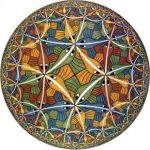I’ve written before about how probabilities are used to understand human perception, understanding, and learning. Joshua Tenenbaum uses probabilistic inferencing to account for how we come to learn concepts, acquire language, and understand the world around us quickly, and with very little information (How to Grow a Mind). Optical illusions are created by statistical judgments […]
|
|||||
|
I find the relationship between mathematics and vision fascinating. Even within mathematics itself, seeing how the geometric expression of ideas can clarify or further develop countless mathematical thoughts is always worth noting – like the graphs of functions, or the projections of figures. I’ve written before about the relationship between the brain’s visual processes and […] 
Recently I became particularly sensitive to discussions that address ‘meaning’ as an emergent property of both biological and formal systems (of which mathematics is one). And this is because it is the meaning of symbols in mathematics that is the source of its power. But it is not at all clear that the meaning of […] 
Deciphering the principles of self-organizing systems is often at the heart of new ideas in biology, including neurobiology. A complex, self-organizing system contains a large number of elements that have predictable, local interactions with each other, but these local interactions create global properties that cannot be predicted from even the most well-understood local events. This […] I have made the argument on more than one occasion that a refreshed look at mathematics may help illuminate the relationship between our experience of the physical and our experience of the thoughtful. Mathematics is a discipline characterized by complex relations among abstract things but, as has been explored from many directions, the action of […] Familiar mathematical structure is found in the neural activity that governs how the body orients itself and navigates its environment. Grid cells are neurons, found in areas neighboring the hippocampus, whose individual firings line up in a coordinate-like pattern according to an animal’s movement across the full extent of its environment. Their grid pattern acts […] 
The slow and steady march toward a more and more precise definition of what we mean by information inevitably begins with Claude Shannon. In 1948 Shannon published The Mathematical Theory of Communication in Bell Labs’ technical journal. Shannon found that transmitted messages could be encoded with just two bursts of voltage – an on burst […] I could go on for quite some time about the difference between dreaming and being awake. I could see myself picking carefully through every thought I have ever had about the significance of dreams, and I know I would end up with a proliferation of questions, rather than a clarification of anything. But I think […] First, I would like to apologize for posting so infrequently these past few months. I have been working hard to flesh out a book proposal closely related to the perspective of this blog, and I will be focused on this project for a bit longer. However, a TED talk filmed in Paris in May came […] A recent issue of New Scientist featured an article by Kate Douglas with the provocative title Nature’s brain: A radical new view of evolution. The limits of our current understanding of evolution, and the alternative view discussed in the article, are summarized in this excerpt: Any process built purely on random changes has a lot […] |
|||||
|
Copyright © 2024 Mathematics Rising - All Rights Reserved Powered by WordPress & Atahualpa |
|||||


Recent Comments